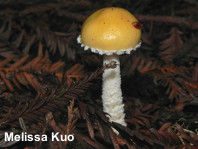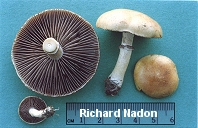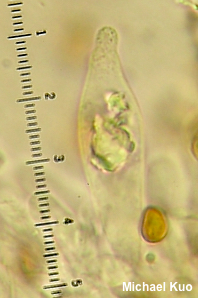 Key to about 20 North American Stropharioid Mushrooms
Key to about 20 North American Stropharioid Mushrooms
| 1. | Fresh cap scarlet to orange. | 2 |
| 1. | Fresh cap otherwise colored (brown, tan, yellow, wine red, purplish, white, green, blue). | 3 |
| 2. | Found in woodchips, landscaping areas, waste places (and so on) in coastal California (perhaps elsewhere?); stem smooth to finely hairy. | |
| 2. | Found in woods across North America; stem shaggy. | |
| 3. | Fresh, young cap with blue or green colors (if stem bruises blue, see Psilocybe). | 4 |
| 3. | Blue or green colors absent. | 6 |
| 4. | Gill edges colored like the faces during all stages of development; ring not usually well developed, even in young specimens; cheilochrysocystidia present; found in woods or on woodchips in urban settings. | |
| 4. | Gill edges often whitish at maturity, contrasting with the faces; ring well developed or not; cheilochrysocystidia absent; found in woods or in grassy areas. | 5 |
| 5. | Cap dark green to dark blue when young, often fading to yellowish; ring fairly well developed, at least when young; usually found in woods on soil, moss, or woody debris. | |
| 5. | Cap bluish or greenish when young, but becoming whitish with faint bluish tints; ring poorly developed, even when young; usually found in grassy areas. | Stropharia pseudocyanea
= S. albocyanea |
| 6. | Mature cap medium sized to large; regularly greater than 5 cm in diameter. | 7 |
| 6. | Mature cap small; rarely greater than 5 cm in diameter. | 13 |
| 7. | Cap without scales, typically wine red when young, becoming brownish--but occasionally brownish when young, or in one form white in all stages of development; ring prominent and well developed, with distinctive bent-back scales or "claws" on its underside; growing in woodchips, landscaping areas, mulch, and so on; spores 11–14 x 7–9 µm. | |
| 7. | Not completely as above. | 8 |
| 8. | Found in western North America (especially northern California and the Pacific Northwest); tall (mature stem 8-15 cm long); cap slimy and yellow, fringed with drooping white veil remnants on the margin. | |
| 8. | Not completely as above. | 9 |
| 9. | Stem conspicuously scaly, especially when young. | 10 |
| 9. | Stem smooth, fibrillose, or slightly shaggy when young, but lacking conspicuous scales. | 12 |
| 10. | Cap yellow and dry, innately scaly ("scales" not merely veil remnants; not easily rubbed off); spores not longer than 8 µ. | |
| 10. | Not completely as above. | 11 |
| 11. | Young cap purple brown to reddish brown; stem 1–2 cm thick; chrysocystidia present on gill faces. | |
| 11. | Young cap yellow to orangish brown; stem 0.5–1 cm thick; chrysocystidia absent. | Leratiomyces squamosus |
| 12. | Found in hardwood forests in eastern North America; cap dull brownish yellow; ring thin but persistent and membranous; spores 6–7 µm long. | |
| 12. | Found in western North America under aspens, cottonwoods, and alders (especially in riparian ecosystems); cap yellowish to whitish; ring fragile, soon disappearing or remaining only as a zone of fibrils; spores 13–16 µm long. | |
| 13. | Young cap wine red; reported from piles of hardwood debris in flooded lowlands in Illinois and Indiana. | |
| 13. | Cap otherwise colored; distribution and ecology various. | 14 |
| 14. | Stem shaggy-scaly; cap slimy, dull yellow to orangish; found in woods; spores 12–14 µm long; chrysocystidia absent. | Leratiomyces squamosus |
| 14. | Not completely as above. | 15 |
| 15. | Growing in grass, on dung, in woodchips, in gardens, and so on. | 18 |
| 16. | Found in western North America under aspens, cottonwoods, and alders (especially in riparian ecosystems); mature cap 3–5 cm across; spores 11–15 µm long; chrysocystidia apparently absent. | |
| 16. | Not completely as above. | 17 |
| 17. | Cap whitish (sometimes with a yellowish center); fresh stem dry; reported from Michigan and California. | Stropharia albonitens |
| 17. | Cap honey yellow; fresh stem with a slimy sheath; reported near Seattle "among leaves in woods" and from Oregon "on humus under spruce." | Stropharia semigloboides |
| 18. | Ring fairly persistent, usually remaining throughout development. | 19 |
| 18. | Ring ephemeral, usually disappearing with maturity or persisting merely as a zone of fibrils. | 21 |
| 19. | Fresh, young cap whitish; spores 10–13 µm long. | |
| 19. | Fresh, young cap yellow to yellowish; spores 7–11 µm long or 13–16 µm long. | 20 |
| 20. | Growing in grassy areas across North America; spores 7–11 x 4.5–5.5 µm. | |
| 20. | Growing in wood chips and in waste places on the West Coast; spores 13–16 x 7–9 µm. | |
| 21. | Fresh stem with a slimy sheath; cap convex to nearly round, but not bell-shaped; spores 15–19 µm long. | |
| 21. | Not completely as above. | 22 |
| 22. | Growing in wood chips in western North America; cap 3–5 cm across, yellow becoming whitish; spores 11–15 µm long. | |
| 22. | Not completely as above. | 23 |
| 23. | Cap 1–2.5 cm across, bell-shaped, yellowish brown with a darker center; spores 17–19 µm long. | Stropharia umbonatescens |
| 23. | Cap slightly larger than above, convex to planoconvex, paler than above; spores shorter. | 24 |
| 24. | Stem about 2 mm thick; widely distributed in North America. | Stropharia siccipes |
| 24. | Stem about 5–10 mm thick; apparently eastern in distribution. | |
References
Atkinson, G. F. (1906). Two new species belonging to Naucoria and Stropharia. Journal of Mycology 12: 193–194.
Bas, C. & M. E. Noordeloos (1996). Notulae ad floram agaricinam neerlandicam XXIX: Two new species of Psilocybe. Persoonia 16: 239–44.
Bridge, P. D., B. M. Spooner, R. E. Beever & D. -C. Park (2008). Taxonomy of the fungus commonly known as Stropharia aurantiaca, with new combinations in Leratiomyces. Mycotaxon 103: 109–121.
Cortez, V. G. & G. Coelho (2004). The Stropharioideae (Strophariaceae, Agaricales) from Santa Maria, Rio Grande do Sul, Brazil. Mycotaxon 89: 355–378.
Cortez, V. G. & R. M. B. da Silveira (2008). The agaric genus Stropharia (Strophariaceae, Agaricales) in Rio Grande do Sul State, Brazil. Fungal Diversity 32: 31–57.
Cortez, V. G. & G. Coelho (2008). Occurrence of the rare agaric Stropharia melanosperma (Strophariaceae) in Brazil. Boletín de la Sociedad Micológica de Madrid 32: 49–56.
Guzmán, G. (1980). Three new sections in the genus Naematoloma and a description of a new tropical species. Mycotaxon 12: 235–240.
Guzmán, G. (1983). The genus Psilocybe. Germany: J. Cramer. 439 pp.
von Kreisel, H. (1977). Zur Taxonomie von Stropharia aeruginosa sensu lato. Sydowia Beihefte 8: 228–232.
Murrill, W. A. (1912). The Agaricaceae of the Pacific Coast: III.Mycologia 4: 294–308.
Noordeloos, M. E. (1995). Notulae ad floram agaricinam Neerlandicam—XXIII. Psilocybe and Pholiota. Persoonia 16: 127–129.
Noordeloos, M. E. (1999). Strophariaceae. In Bas, C. et al., eds. Flora Agaricina Neerlandica Volume 4. Rotterdam: A. A. Balkema; pp 27–107.
Noordeloos, M. E. (2001). Studies in Psilocybe sect. Psilocybe. Osterr. Z. Pilzk. 10: 115–180.
Ramírez-Cruz, V., G. Guzmán, A. R. Villalobos-Arámbula, A. Rodriguez, P. B. Matheny, M. Sánchez-Garcia & L. Guzmán-Dávalos (2013). Phylogenetic inference and trait evolution of the psychedelic mushroom genus Psilocybe sensu lato (Agaricales). Botany 91: 573–591.
Ryman, S. (2018). Stropharia. In Knudsen, H. & J. Vesterholt, eds. Funga Nordica: Agaricoid, boletoid and cyphelloid genera. Copenhagen: Nordsvamp. 851–855.
da Silva, P. S., R. M. B. da Silveira & V. G. Cortez (2014). Notes on Deconica and Psilocybe (Agaricales) from the southern border of Atlantic forest and Pampa biomes of Brazil. Sydowia 66: 217–228.
Smith, A. H. (1937). Notes on agarics from the western United States. Bulletin of the Torrey Botanical Club 64: 477–487.
Smith, A. H. (1941). Studies of North American agarics—I. Contributions from the University of Michigan Herbarium 5: 1–73.
Smith, A. H. (1951). North American species of Naematoloma. Mycologia 43: 466–521.
Smith, A. H. (1979). Stropharia riparia, a previously undescribed species suspected of occurring in Michigan. The Michigan Botanist 18: 107–108.
Stamets, P. E. (1978). Psilocybe mushrooms and their allies. Seattle: Homestead Book Company. 160 pp.
Stamets, P. E., M. W. Beug & J. E. Bigwood (1980). A new species and a new variety of Psilocybe from North America. Mycotaxon 11: 476–484.
Stamets, P. (2003). Psilocybin Mushrooms of the World: An Identification Guide. Berkeley, CA: Ten Speed Press.
Vesterholt, J. (2008). Psilocybe. In Knudsen, H. & J. Vesterholt, eds. Funga Nordica: Agaricoid, boletoid and cyphelloid genera. Copenhagen: Nordsvamp. 844–851.
Watling, R. & N. M. Gregory (1987). 4. Stropharia. In British Fungus Flora, Agarics and Boleti 5: Strophariaceae & Coprinaceae. Edinburgh: Royal Botanic Garden. 56–69.
This site contains no information about the edibility or toxicity of mushrooms.
Cite this page as:
Kuo, M. (2018, November). Stropharioid mushrooms. Retrieved from the MushroomExpert.Com Web site: http://www.mushroomexpert.com/stropharioid.html
© MushroomExpert.Com



